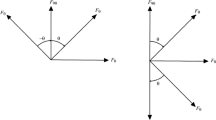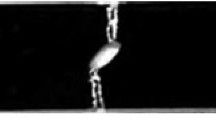Abstract
This paper improves the two stress fracture criteria proposed by Whitney and Nuismer (known as the point stress criterion and the average stress criterion) to predict the strength of composite laminates with a circular hole. In the point stress criterion, it is assumed that the failure occurs when the stress over some distance (d 0) away from the notch is equal to or greater than the un-notched laminate strength. In the average stress criterion it is assumed that failure occurs when the average stress over some distance (a 0) ahead of the notch equals the unnotched laminate strength. Both stress fracture criteria are two parameter models based on the unnotched strength (σ 0) and a characteristic dimension (d 0 ora 0). A simple relation is used for the characteristic length to improve the accuracy while evaluating the notched strength of carbon/epoxy composite laminates. The analytical results are compared well with the existing test results of AS4-carbon/948 Al epoxy [0/90]4s and [0/ ± 45/90]2S composite laminates with various hole diameters and specimen widths.
Zusammenfassung
In diesem Artikel wird eine verbesserte Form der Bruchspannungskriterien von Whitney und Nuismer vorgestellt, die für die Berechnung der Spannungen in Verbundíaminaten verwendet wird, weiche eine runde Öffnung aufweisen. Der Ansatz mit einem lokalen spannungskriterium geht davon aus, daß ein Versagen des Werkstoffes dann auftritt, sobald die Spannung in einer bestimmmten Entfernungd 0 von der Kerbe die Festigkeit des ungekerbten Laminates übserschreitet. Der Ansatz des mittleren Spannungskriterium legt zugrunde, daß ein Materialversagen dann auftritt, wenn die mittlere Spannung in einer bestimmten Entfernunga 0 von der Einkerbung die Festigkeit des ungekerbten Laminates überschreitet. Beide Bruchspannungsansätze sind zwei-parametrische Berechnungsansätze basierend auf der Festigkeitσ 0 des kerbfreien Material und einer charakteristischen Länged 0 bzw.a 0. Eine relativ einfache Beziehung wird für die Bestimmung der charakteristischen Länge eingeführt, um die Berechnung der Kerbfestigkeit von Kohlefaser/Epoxid-Verbund-Laminaten zu verbessern. Die erhaltenen, analytischen Ergebnisse stimmen gut mit den verfügbaren Meßwerten von AS4-carbon/948 Al epoxy [0/90]4S and [0/± 45/90]2S Verbund-Laminaten unterschiedlicher Abmessungen überein.
Similar content being viewed by others
Abbreviations
- a 0 :
-
characteristic length for the average stress criterion
- c :
-
half-crack length
- c p ,c k :
-
notch sensitivity parameters
- d 0 :
-
characteristic length for the point stress criterion
- D(≡2R):
-
hole diameter
- E xx ,E yy ,G xy :
-
axial, transverse and shear moduli respectively
- K 1 :
-
stress intensity factor
- K Q,∞ :
-
asymptotic value of the stress intensity factor
- K F ,K F1,K F2 :
-
fracture toughness parameters
- K ∞ T ,K T :
-
stress concentration factors for infinite and finite width plates
- m, m 1,m 2 :
-
fracture parameters
- m p ,m k :
-
exponential parameters
- M :
-
magnification factor
- R :
-
hole radius
- R 0 :
-
reference radius
- W :
-
specimen width
- x.y :
-
axial and transverse directions
- ν xy :
-
Poisson’s ratio
- ν yx :
-
ν xy E yy /E xx
- Φ1 :
-
R/(R +d 0)
- Φ2 :
-
R/(R +a 0)
- Φ3 :
-
c/(c +d 0)
- Φ4 :
-
c/(c +a 0)
- σ 0 :
-
unnotched strength of laminate
- σ y :
-
normal stress alongy-direction
- σ ∞ N :
-
applied uniform stress alongy-direction
- σ ∞ N ,σ N :
-
notched strength for infinite and finite width plates
References
Waddoups ME, Eisenmann JR, Kaminski BE (1971) Macroscopic fracture mechanics of advanced composite materials. J. of Composite Materials, 5, 446–454
Whitney JM, Nuismer RJ (1974) Stress fracture criteria for laminated composites containing stress concentrations. J. of Composite Materials, 8, 253–265
Nuismer RJ, Whitney (1975) Uniaxial failure of composite laminates containing stress concentrations. ASTM STP 593, 117–142
Pipes RB, Wetherhold RC, Gillesic JW (1980) Macroscopic fracture of fibrous composites. Materials Science and Engineering, 45, 247–253
Backlund J, Aronsson CG (1986) Tensile fracture of laminates with holes. J. of Composite Materials, 20, 259–285
Tan SC (1988) Finite width correction factor for anisotropic plate containing central opening. J. of Composite Materials, 22, 1080–1097
Kortschot MT, Beamont PWR (1990) Damage mechanics of composite materials: measurements of damage and strength. Composite Science and Technology, 39, 289–301
Eriksson I, Aronsson CG (1990) Strength of tensile loaded graphite/epoxy laminates containing cracks, open and filled holes”. J. of Composite Materials, 24, 456–482
Jung-Kyu Kim, Do-Sik Kim, Takeda N (1995) Notched strength and fracture criterion in fabric composite plates containing a circular hole. J. of Composite Materials, 29, 982–998
Akbar Afagi-Khatibi, Lin Ye, Yiu-Wing Mai (1996) An effective crack growth model for residual strength evaluation of composite laminates with circular holes. J. of Composite Materials, 30, 142–163
Lekhnitskii SG (1968) Anisotropic plates. Translated from the second Russian Edition by S. W. Tsai and T. Cheron, New York, Gordon and Breach, Science Publishers, Inc.
Konish HJ, Whitney JM (1975) Approximate stress in an orthotropic plate containing a circular hole. J. of Composite Materials, 9, 157–166
Newman JC (1976) Fracture analysis of various cracked configurations in sheet and plate materials. ASTM STP 605, 104–123
Nageswara Rao B (1992) Instability load for cracked configurations in plate materials. Int. J. of Engineering Fracture Mechanics, 43, 887–893
Nageswara Rao B, Acharya AR (1997) Failure assessment of 34 Cr Mo4 grade steel cylindrical pressure vessels with an axial surface crack. Int. J. of Pressure Vessels and Piping, 72, 157–163
Author information
Authors and Affiliations
Rights and permissions
About this article
Cite this article
Govindan Potti, P.K., Nageswara Rao, B. & Srivastava, V.K. Notched strength of carbon fibre/epoxy composite laminates with a circular hole. Forsch Ing-Wes 65, 295–300 (1999). https://doi.org/10.1007/BF03035110
Received:
Issue Date:
DOI: https://doi.org/10.1007/BF03035110




